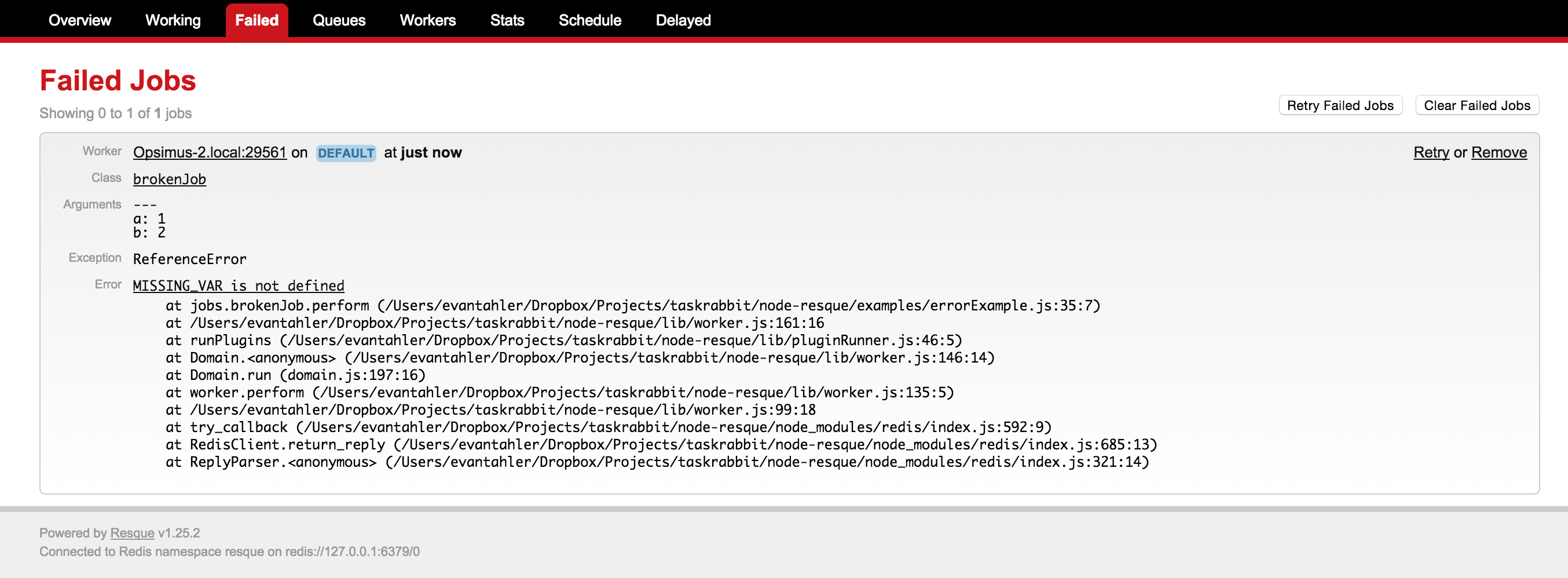node-resque
Advanced tools
node-resque - npm Package Compare versions
Comparing version 6.0.1 to 6.0.2
@@ -6,7 +6,7 @@ { | ||
| "license": "Apache-2.0", | ||
| "version": "6.0.1", | ||
| "homepage": "http://github.com/taskrabbit/node-resque", | ||
| "version": "6.0.2", | ||
| "homepage": "http://github.com/actionhero/node-resque", | ||
| "repository": { | ||
| "type": "git", | ||
| "url": "git://github.com/taskrabbit/node-resque.git" | ||
| "url": "git://github.com/actionhero/node-resque.git" | ||
| }, | ||
@@ -13,0 +13,0 @@ "main": "dist/index", |
@@ -7,3 +7,3 @@ # node-resque: The best background jobs in node. | ||
| [](https://circleci.com/gh/taskrabbit/node-resque) | ||
| [](https://circleci.com/gh/actionhero/node-resque) | ||
@@ -268,3 +268,3 @@ ## API Docs | ||
| - This project implements the "scheduler" part of rescue-scheduler (the daemon which can promote enqueued delayed jobs into the work queues when it is time), but not the CRON scheduler proxy. To learn more about how to use a CRON-like scheduler, read the [Job Schedules](#job-schedules) section of this document. | ||
| - "Namespace" is a string which is appended to the front of your keys in redis. Normally, it is "resque". This is helpful if you want to store multiple work queues in one redis database. Do not use `keyPrefix` if you are using the `ioredis` (default) redis driver in this project (see https://github.com/taskrabbit/node-resque/issues/245 for more information.) | ||
| - "Namespace" is a string which is appended to the front of your keys in redis. Normally, it is "resque". This is helpful if you want to store multiple work queues in one redis database. Do not use `keyPrefix` if you are using the `ioredis` (default) redis driver in this project (see https://github.com/actionhero/node-resque/issues/245 for more information.) | ||
| - If you are using any plugins which effect `beforeEnqueue` or `afterEnqueue`, be sure to pass the `jobs` argument to the `new NodeResque.Queue()` constructor | ||
@@ -302,3 +302,3 @@ - If a job fails, it will be added to a special `failed` queue. You can then inspect these jobs, write a plugin to manage them, move them back to the normal queues, etc. Failure behavior by default is just to enter the `failed` queue, but there are many options. Check out these examples from the ruby ecosystem for inspiration: | ||
|  | ||
|  | ||
@@ -319,3 +319,3 @@ You can work with these failed jobs with the following methods: | ||
| We use a try/catch pattern to catch errors in your jobs. If any job throws an uncaught exception, it will be caught, and the job's payload moved to the error queue for inspection. Do not use `domains`, `process.onExit`, or any other method of "catching" a process crash. The error paylaod looks like: | ||
| We use a try/catch pattern to catch errors in your jobs. If any job throws an uncaught exception, it will be caught, and the job's payload moved to the error queue for inspection. Do not use `domains`, `process.onExit`, or any other method of "catching" a process crash. The error payload looks like: | ||
@@ -346,3 +346,3 @@ ```javascript | ||
| To modify the 60 minute check, change `stuckWorkerTimeout` when configuring your scheudler, ie: | ||
| To modify the 60 minute check, change `stuckWorkerTimeout` when configuring your scheduler, ie: | ||
@@ -377,3 +377,3 @@ ```js | ||
| Assuming you are running node-resque across multiple machines, you will need to ensure that only one of your processes is actually scheduling the jobs. To help you with this, you can inspect which of the scheduler processes is currently acting as master, and flag only the master scheduler process to run the schedule. A full example can be found at [/examples/scheduledJobs.js](https://github.com/taskrabbit/node-resque/blob/master/examples/scheduledJobs.js), but the relevant section is: | ||
| Assuming you are running node-resque across multiple machines, you will need to ensure that only one of your processes is actually scheduling the jobs. To help you with this, you can inspect which of the scheduler processes is currently acting as master, and flag only the master scheduler process to run the schedule. A full example can be found at [/examples/scheduledJobs.js](https://github.com/actionhero/node-resque/blob/master/examples/scheduledJobs.js), but the relevant section is: | ||
@@ -393,3 +393,3 @@ ```javascript | ||
| if (scheduler.master) { | ||
| console.log(">>> enquing a job"); | ||
| console.log(">>> enqueuing a job"); | ||
| await queue.enqueue("time", "ticktock", new Date().toString()); | ||
@@ -616,3 +616,3 @@ } | ||
| - Most of this code was inspired by / stolen from [coffee-resque](https://npmjs.org/package/coffee-resque) and [coffee-resque-scheduler](https://github.com/leeadkins/coffee-resque-scheduler). Thanks! | ||
| - This Resque package aims to be fully compatible with [Ruby's Resque](https://github.com/resque/resque) and implementations of [Resque Scheduler](https://github.com/resque/resque-scheduler). Other packages from other langauges may conflict. | ||
| - This Resque package aims to be fully compatible with [Ruby's Resque](https://github.com/resque/resque) and implementations of [Resque Scheduler](https://github.com/resque/resque-scheduler). Other packages from other languages may conflict. | ||
| - If you are looking for a UI to manage your Resque instances in nodejs, check out [ActionHero's Resque UI](https://github.com/evantahler/ah-resque-ui) |
New alerts
New author
Supply chain riskA new npm collaborator published a version of the package for the first time. New collaborators are usually benign additions to a project, but do indicate a change to the security surface area of a package.
Found 1 instance in 1 package
Improved metrics
- Total package byte prevSize
642703
Worsened metrics
- Number of medium supply chain risk alerts
- increased byInfinity%
1